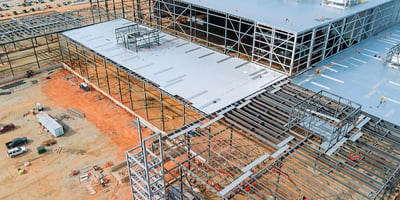Construction falls into several different categories. Residential, infrastructure, commercial, and industrial are the biggest. Residential construction is obvious: Homes, multi-family units, apartment buildings, and so on. Infrastructure is pretty simple, too. That category covers everything from roads and bridges to airports, water, wastewater systems, and more.
But what’s the difference between commercial and industrial construction? Here, things are a little less clear.
We’re going to explain what separates commercial and industrial construction. We’re also going to talk about the Aerico® 90 Strip Nailer, which is a tool made to drive collated pins into steel and concrete—two common materials that are often worked with in both commercial and industrial construction.
What Differentiates Commercial and Industrial Construction?
It’s easy to confuse these two types of construction—and that’s because if you think about it, industrial facilities have a commercial element to them since most are designed to produce products to sell. But it’s the “production” part of the equation that is the main differentiator.
Industrial construction builds facilities that produce a product. Factories, steel mills, power plants, refineries, manufacturing facilities—these are all examples of industrial construction, and each will be designed to mass produce a particular product that businesses will either sell wholesale to retailers, or in the case of facilities like power plants, direct to consumers.
Commercial construction is all about building customer-oriented facilities where commerce can take place. Examples include stores, shopping malls, hotels, gyms, restaurants, hospitals, and so on.
Key Factors that Differentiate Commercial and Industrial Construction
Now that we’ve explained the basic difference between commercial and industrial facilities—production versus commerce—it’s time to look at some of the specific ways construction differs between these two categories.
1) Design
First and foremost, design is among the biggest differences. In industrial construction, it’s all about practicality and optimizing costs. Project managers will be looking for ways to make industrial facilities as efficient as possible during both the construction and operation phases—and they’ll spare very little of their budget on aesthetic upgrades that will do little to improve operation or lower costs.
Commercial facilities need to strike a balance between practicality, cost optimization and sustainability, and aesthetics. Thus, builders and project managers will need to consider ways to create functional spaces that are as efficient as possible—while also spending more on aesthetic choices, even when those aesthetic choices may not be the most efficient way to build. For example, even though windows aren’t as energy efficient as walls, storefronts will still need large, attractive windows to give consumers a great view of what’s for sale.
2) Building Systems
Every building, commercial or industrial, will need mechanical, electrical, and plumbing systems. In commercial buildings, this usually means heating and cooling plus electrical and plumbing—though some facilities, like grocery stores or hospitals, will need more specialized systems for things like refrigeration or certain medical systems.
In industrial construction, building systems can be a whole lot more complicated. The building will still need heating, cooling, electrical, and plumbing—but these systems will usually need to be much bigger and more complex to support the operation of heavy machinery or production lines. Additionally, there will usually be additional systems to build out, like systems for handling pressurized gasses, plumbing for acids or other chemicals used in production and refinement, waste treatment systems, and so on.
3) Location Selection
For builders looking to buy property to build on, location is a big consideration—and vastly different between commercial and industrial construction. For commercial construction, owners want to make sure that people have easy access to the building. This means choosing locations near shopping hubs or in easy-to-find locations in active communities so that people can find and access the business. Zoning and permitting regulations in a given area are also a consideration depending on the type of commercial building desired.
Where industrial construction is concerned, it’s important to factor in three things. First—pay close attention to zoning and permitting regulations since many areas will have concerns about noise, pollution, waste treatment, or other potential issues.
Next, look for areas near major transit arteries. For industrial construction, don’t worry about making it easy for vast numbers of consumers to find the business—but select a place that makes it easy to transport vast quantities of product to and from the facility. That means building near major highways, railways, or even waterways to help facilitate shipping.
Last, make sure to find plots of land that offer adequate space. You’ll need room not just for factories or production lines, but also parking, spaces for warehousing, separate areas for the building’s future maintenance crew, and more.
4) Choosing the Right Materials & Tools
Another key distinction lies in the materials utilized. While residential building commonly relies on timber framing, commercial and industrial construction predominantly involves extensive use of concrete foundations and steel framing. Consequently, a robust fastener system becomes crucial for such tasks.
Enter the Aerico® 90 Strip Nailer from BECK—purposefully designed for precisely these scenarios. This tool is tailored to fastening within steel and concrete substrates, possessing ample power to securely embed nails into poured concrete or 3/16” steel. Compatible with pins ranging from 1 ¼” to 2 ¼” in length, it accommodates both smooth and knurled shanks to suit your grip preferences.
To delve deeper into the capabilities of the Aerico® 90 and its accompanying fastener system, simply click below for further details.👇
.svg.png)


